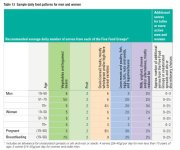I believe most people have never read the nutritional guidelines in their respective countries and statistically, here in Australia only around %5 of people actually eat within those guidelines.
https://www.nhmrc.gov.au/adg
These are the Guidelines for Australia, with the added bonus of having access to download the "Educators Guide" this guide set out how a non registered dietitian can provide a nutritional plan that stay within the national guidelines without counting calories and allowing coaches,trainers and nutritionists to stay within scope of practice.
https://www.nhmrc.gov.au/adg
These are the Guidelines for Australia, with the added bonus of having access to download the "Educators Guide" this guide set out how a non registered dietitian can provide a nutritional plan that stay within the national guidelines without counting calories and allowing coaches,trainers and nutritionists to stay within scope of practice.

